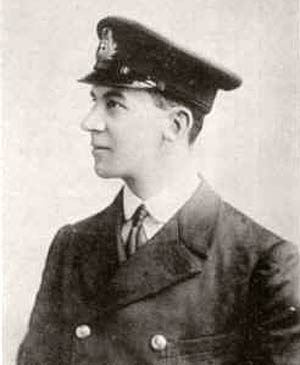
Lieutenant, Richard Douglas Sandford, V C
Page updated 13th May 2011
Return to Exeter People Menu
Born in Exeter on the 11th May 1891, Lieutenant Sandford won the Victoria Cross in charge of that new, and frightening, weapon of war the submarine.
He was the seventh son of the Venerable Ernest Grey Sandford, Archdeacon of Exeter, while his grandfather, the Right Rev. Daniel Sandford, had been Bishop of Edinburgh. At the time of his death, his mother lived in Exmouth.
The young Sandford attended Clifton College before joining the Royal Navy in 1904. This was a British Navy that was in the process of rapid change with the new, deadly Dreadnought class and the introduction of submarines into the fleet.
In 1914, at the age of 23, Sandford volunteered, for the submarine service. By the age of 26, Sandford was a Lieutenant in command of the elderly HMS C3. He was known as 'Uncle Baldy' for his cheerful and mock elder statesman manner by his crew.
German submarines were exacting a heavy toll on Allied shipping requiring the Admiralty to devise a plan to prevent them leaving their port at Zeebrugge. A raid on the port by two thousand men of the Royal Navy and Royal Marines under the command of Vice-Admiral Sir Roger Keyes was planned for the 22nd and 23rd April 1918, with the intention of destroying the facility and its ability to support the German submarines. Marines and sailors landed and stormed the enemy defences, while the ships HMS Thetis, Intrepid and Iphignia were scuttled along with the submarine C3, commanded by Lieutenant Sandford. C3 carrying five tons of amatol was steered into position without gyro steering to ensure his ship was correctly targeted. Sandford had to light the fuse before abandoning ship with his five crew mates in a skiff. Sandford, and two of his crew, Harmer and Bindall were badly wounded by the explosion before they were picked up by HMS Phoebe and taken to Dover.
On the 19th July 1918 the London Gazette published the following citation "For most conspicuous gallantry. This officer was in command of Submarine C.3. and most skilfully placed that vessel in between the piles of the viaduct before lighting his fuse and abandoning her. He eagerly undertook this hazardous enterprise, although well aware (as were all his crew) that if the means of rescue failed and he or any of his crew were in the water at the moment of the explosion, they would be killed outright by the force of such explosion. Yet Lieutenant Sandford disdained to use the gyro steering, which would have enabled him and his crew to abandon the submarine at a safe distance, and preferred to make sure, as far as was humanly possible, of the accomplishment of his duty."
Captain Edward Bamford and Serjeant Norman Finch were also awarded the Victoria Cross for their work that night - such was the bravery shown by many, that the pair were selected by ballot of the men themselves. Lieutenant Sandford survived the war, only to die of typhoid on the 23rd November, in the Eston Council Building, Cleveland Hospital, Grangetown, just twelve days after the signing of the Armistice. He was buried in Eston Cemetery near Middlesbrough, where he is still honoured every Armistice Day with red poppies. In 1927 a memorial tablet was unveiled to HMS C3 at the spot where the submarine breached the mole at Zeebrugge.
His brother, Brigadier Daniel Arthur Sandford was an officer in the British Army. He resigned his commission after the First War and became an advisor to the Ethiopian Emperor Haile Selassie.
 Lieutenant Richard Douglas Sandford VC
Lieutenant Richard Douglas Sandford VC
 HMS C3
HMS C3
│ Top of Page │